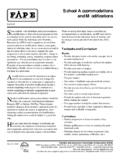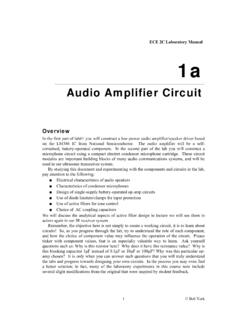Transcription of JULIAN WHEATLEY - Yale University
1 Learning Chinese Sample . Learning Chinese A FOUNDATION COURSE IN MANDARIN. JULIAN K. WHEATLEY . YALE University PRESS NEW HAVEN & LONDON. Copyright 2011 Yale University Learning Chinese Sample Learning Chinese comes with an extensive set of audio clips that serve as a personal guide to the Chinese language material in the book. These, as well as vocabulary lists (both Chinese-to-English and English-to-Chinese), keys to exercises, and other special features, can be found at the com- panion website Copyright 2011 Yale University Learning Chinese Sample . PREFACE. A. Ten basic features of Learning Chinese 1. Provides instruction in spoken and written Mandarin; no prior background assumed. 2. Serves as a comprehensive resource for the foundation levels of Chinese language study.
2 Learning Chinese ( rst year) and the forthcoming compan- ion volume (second year) cover approximately 200 class hours. 3. Includes sample schedules for all 200 hours of class study. 4. Presents rich content (based on the author's own experience learning Chinese) that is presented incrementally and in detail, is carefully sequenced, and builds toward dialogues or narratives that recapitulate important content. 5. Includes a variety of exercises and audio materials for self-study. The com- panion website, , provides a full set of audio clips, as well as comprehensive vocabulary lists, exercise keys, and other features. 6. Contains content that is easily transformed into class activities, and easily supplemented by online or other materials.
3 7. Includes conversational lessons and character lessons that can be used separately or together. 8. Includes conversational and character lessons that are related but not iden- tical to each other, and which can be interleaved. 9. Teaches reading with both the traditional (Taiwan) and simpli ed (Main- land) character sets. 10. Teaches characters inductively, by emphasizing reading in context as much as possible. xv Copyright 2011 Yale University Learning Chinese Sample xvi PREFACE.. ! . ! . 200 . ! 200 . ! .. ! ) y a l e b o o k s . c o m /. WHEATLEY ) . ! . ! . ! . ! . ! .. B. Ten general principles for using Learning Chinese 1. Prepare before class, perform in class, and consolidate after class.
4 2. Move from simple to complex, from familiar to novel, and from rote to realistic. 3. Focus on typical interchanges, personalize them when possible, and com- pound them into longer conversations. 4. Recognize that Mandarin usage varies as much as English. Regard Learning Chinese as a guide, but accept additional input from teachers and your own observations. 5. Learn functional phrases rather than individual words; visualize interac- tions and match appropriate language; and act out scenarios from cues. 6. Distinguish character recognition from reading, and focus reading activi- ties on comprehension. 7. Write characters to improve recognition ability, but utilize word processing programs to compose texts.
5 Copyright 2011 Yale University Learning Chinese Sample PREFACE xvii 8. Consolidate conversational skills while studying the character units; con- solidate character skills while studying the conversational units. 9. As much as possible, learn language in context rather than from lists. (But be mindful that lists can help with recall and review.). 10. Know the core, test the core ( , that practiced in class). For character material, test comprehension.. ! . ! . ! . ! .. ! .. ! . ! .. ! .. ! ) . *. ! .. Copyright 2011 Yale University Learning Chinese Sample . INTRODUCTION. Goals and methods The language This is a course in Standard Chinese, a language that is often colloquially referred to as Mandarin.
6 The origins of this language and its position in the Chinese-speaking world will be discussed below, in the section on linguistic background. Variation Given the geographic spread of Mandarin across the Chinese-speaking world, and its function as a lingua franca co-existing with regional and local languages, it is not surprising that it demonstrates a broad range of variation in pronun- ciation, word choice, grammar, and usage. Some speakers, by virtue of geo- graphic origin or educational background, may claim to be arbiters of good'. and bad' Mandarin, particularly in matters of pronunciation, where the edu- cated speech of Beijing is generally considered to be standard. However, when it comes to the pronunciation of individual words, word choice, particular nuances of meaning, grammatical organization of sentences, or linguistic usage, Chinese displays a range of variation comparable to, or perhaps greater than, that of English, and such variation is only likely to grow as contact with foreigners increases and the Chinese language spreads beyond the borders of China.
7 Xxi Copyright 2011 Yale University Learning Chinese Sample xxii INTRODUCTION. Learning Chinese recognizes a standard sound system for Mandarin (as rep- resented in the pinyin system of romanization) but otherwise accepts a broad range of usage, much of it conditioned by social or geographic factors. Where particular usage can be labeled (as, for example, Taiwan' or southern China'), it is. There may also be unlabeled linguistic material in Learning Chinese that is judged aberrant by teachers or other native speakers of the language. Such judgments should be noted, but they too may need to be revised as you continue to observe the language in its full richness, as it is actually spoken or written.
8 The audience Though students who already have some ability in Chinese will, in many cases, nd this course useful, it does not assume any prior background in the lan- guage. Learning Chinese is intended for a diverse audience, specialist and non- specialist alike, who need a course that not only guides them toward basic conversational and literary skills but also stimulates their curiosity about the linguistic setting of the language and the geography, history, and culture of the lands where it is spoken. Learning Chinese is intended to provide a solid foun- dation for further study of the language, whether in a specialized program of Chinese studies or in conjunction with work or further study in a Chinese- speaking environment.
9 A foundation When you begin studying a language, a lot of time has to be spent familiarizing yourself with the code': the sounds, words, and organization of the language. There comes a point, after a year or two of (non-intensive) study, when you have acquired a critical mass of language material and, provided you remain observant and responsive to feedback, can start to learn effectively from direct interaction with native speakers. This is also the point at which the notion of immersion begins to make sense, and when going abroad to study the language in a completely immersive setting offers the maximum bene t. This textbook is designed to get you to that point. With the additional materials recommended within, it covers approximately 200 class hours a year and a half to two years in a regular course of study.
10 Copyright 2011 Yale University Learning Chinese Sample INTRODUCTION xxiii Self-instruction With help from a Chinese speaker, particularly in the early stages of language development, Learning Chinese can also serve as a manual for self-instruction. It introduces the language systematically; it has extensive explanations about usage, as well as suggestions about how to learn the material within; it provides a pathway for the inductive learning of both conversational and literary skills;. and it comes with a selection of audio les and other materials that can be accessed electronically. Goals summarized Succinctly, the goals of Learning Chinese are: (a) a basic conversational compe- tence, which means mastery of pronunciation and familiarity with a repertoire of useful conversational situations, including some, involving language and cultural issues, that allow you as a learner to explore topics of interest; (b) an understanding of the reading process and the properties of the character writing system so that you can begin to develop a reading competence by way of edited texts written in either the simpli ed or the traditional character set.








